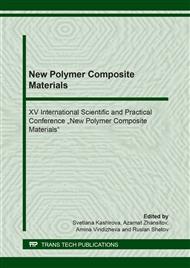[1]
Rafael A. Auras et al. Poly(lactic acid): synthesis, structures, properties, processing, and applications. JonhWiley&Sons. Ins. p.2010. (2037).
Google Scholar
[2]
Hamad K. et al. Properties and medical applications of polylactic acid: a review // eXPRESS Polymer Letters. 2015. Vol. 9, №5. P. 435–455.
Google Scholar
[3]
Langer R., David A. Tirrell. Designing materials for biology and medicine // Nature. 2004. Vol. 428, P. 487–492.
DOI: 10.1038/nature02388
Google Scholar
[4]
Davachi S.M., Kaffashi B. Polylactic Acid in Medicine // Polymer-Plastics Technology and Engineering. 2015. Vol. 54, P. 944–967.
DOI: 10.1080/03602559.2014.979507
Google Scholar
[5]
Ploypetcharaa N., P.Suppakula, D. Atongc Blend of polypropylene/poly(lactic acid) for medical packaging application: physicochemical, thermal, mechanical, and barrier properties / // Energy Procedia. 2014. Vol. 56., Р.201–210.
DOI: 10.1016/j.egypro.2014.07.150
Google Scholar
[6]
Davachi S.M. Interface modified polylactic acid/starch/poly-caprolactone antibacterial nanocomposite blends for medical applications // Carbohydrate Polymers. 2017. Vol. 155. Р. 336–344.
DOI: 10.1016/j.carbpol.2016.08.037
Google Scholar
[7]
Alsaheb R.A.A. et al. Recent applications of polylactic acid in pharmaceutical and medical industries // Journal of Chemical and Pharmaceutical Research, 2015, 7(12). Р. 51-63.
Google Scholar
[8]
Weiler A.et al. Foreign-body reaction and the course of osteolysis after polyglycolide implants for fracture fixation experimental study in sheep // The journal of bone and joint surgery. 1996. Vol. 78-B, № 3. Р. 370-376.
DOI: 10.1302/0301-620x.78b3.0780369
Google Scholar
[9]
Cai X. et al. Preparation and characterization of homogeneous chitosan–polylactic acid/hydroxyapatite nanocomposite for bone tissue engineering and evaluation of its mechanical properties // Acta Biomaterialia. 2009. Vol. 5, Issue 7, P. 2693-2703.
DOI: 10.1016/j.actbio.2009.03.005
Google Scholar
[10]
Bernd Steinhoff et al. PLA-Based Biodegradable and Cytocompatible Implant Materials: Material Development, Processing and Properties // J. Mater. Sci. Eng. 2018. Vol. 3, № 10. P. 619–632.
DOI: 10.17265/2161-6221/2013.10.001
Google Scholar
[11]
Baciu D.E. Non-Metallic Biomaterials for Bone Substitutes and Resorbable Biomaterials in Orthopaedics // National Technical University of Athens. 2004. 102 p.
Google Scholar
[12]
Morokov E.S. et al. Structural and mechanical properties of PLA-hydroxyapatite composites studied by the scanning impulse acoustic microscopy / AIP Conf. Proc. 2018. Vol. 1981. P. 1–5. 13] RU 2451519. Subcutaneous implants containing polylactide-resistant polymer degradation / K.-T. Kramer, G. Schütz, Z.-L. Anna. publ. 03/20/(2007).
DOI: 10.1063/1.5046000
Google Scholar
[14]
Lunt J. Large-scale production, properties and commercial applications of polylactic acid polymers // Polymer Degradation and Stability. 1998. Vol. 59. P.145-152.
DOI: 10.1016/s0141-3910(97)00148-1
Google Scholar
[15]
Gruber P.R. Cargoill Dow LLC / Journal of industrial ecology. 2004. Vol. 7. № 3-4. Р. 209-213.
Google Scholar
[16]
Mevliyanova M.D., Khisamieva D.R., Pesternnikova N.N., Galimzyanova R.Yu. Polylactic acid market review // Professional of the Year 2018: collection of articles of the XI International Scientific Research Competition. Penza: ICNS Science and Enlightenment,. 2018. 22-25 s.
Google Scholar


